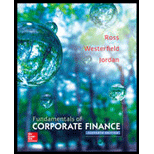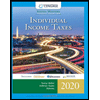
Fundamentals of Corporate Finance
11th Edition
ISBN: 9780077861704
Author: Stephen A. Ross Franco Modigliani Professor of Financial Economics Professor, Randolph W Westerfield Robert R. Dockson Deans Chair in Bus. Admin., Bradford D Jordan Professor
Publisher: McGraw-Hill Education
expand_more
expand_more
format_list_bulleted
Question
Chapter 12, Problem 2M
Summary Introduction
Case summary:
Company S hired Person X. Person X accepted the job because he felt that the company had a good potential growth. At the end of the first day, Person C met Person X and introduced him to the 401(k) plan. It is a retirement plan that the companies offer to their employees.
The employee has to contribute money from his pre-tax income to the 401(k) plan. The company would also contribute a maximum of 5 percent of the salary to the plan. The plan has the following options for investments:
- 1. Investment in company stock
- 2. Investment in B “S and P” 500 index fund
- 3. Investment in B small-cap fund
- 4. Investment in B large-company stocks fund
- 5. Investment in B Bond fund
- 6. Investment in B
money market fund
Characters in the case:
- Company S: The recruiter
- Person X: The new employee
- Person C: The employee of Company S working in Finance section of the company
To determine: The effective annual percentage rate.
Introduction:
Effective annual percentage rate refers to the annual percentage yield from the investment in a given year.
Expert Solution & Answer
Want to see the full answer?
Check out a sample textbook solution
Students have asked these similar questions
What is the effective annual rate (EAR) for a nominal interest rate of 12% compounded monthly?
A) 12.00%B) 12.36%C) 12.68%D) 13.00%
Don't use chatgpt.
The beta of a stock is 1.2, the risk-free rate is 3%, and the expected market return is 9%. What is the expected return of the stock using the CAPM?
A company's stock is expected to grow at 5% annually. The next dividend is $3, and the required rate of return is 10%. What is the stock’s value using the Gordon Growth Model?
Chapter 12 Solutions
Fundamentals of Corporate Finance
Ch. 12.1 - Prob. 12.1ACQCh. 12.1 - Why are unrealized capital gains or losses...Ch. 12.1 - What is the difference between a dollar return and...Ch. 12.2 - Prob. 12.2ACQCh. 12.2 - Why doesnt everyone just buy small stocks as...Ch. 12.2 - What was the smallest return observed over the 88...Ch. 12.2 - About how many times did large-company stocks...Ch. 12.2 - What was the longest winning streak (years without...Ch. 12.2 - How often did the T-bill portfolio have a negative...Ch. 12.3 - Prob. 12.3ACQ
Ch. 12.3 - What was the real (as opposed to nominal) risk...Ch. 12.3 - Prob. 12.3CCQCh. 12.3 - What is the first lesson from capital market...Ch. 12.4 - In words, how do we calculate a variance? A...Ch. 12.4 - With a normal distribution, what is the...Ch. 12.4 - Prob. 12.4CCQCh. 12.4 - What is the second lesson from capital market...Ch. 12.5 - Prob. 12.5ACQCh. 12.5 - Prob. 12.5BCQCh. 12.6 - What is an efficient market?Ch. 12.6 - Prob. 12.6BCQCh. 12 - Chase Bank pays an annual dividend of 1.05 per...Ch. 12 - The risk premium is computed as the excess return...Ch. 12 - Prob. 12.4CTFCh. 12 - Prob. 12.5CTFCh. 12 - Prob. 12.6CTFCh. 12 - Investment Selection [LO4] Given that Fannie Mae...Ch. 12 - Prob. 2CRCTCh. 12 - Risk and Return [LO2, 3] We have seen that over...Ch. 12 - Market Efficiency Implications [LO4] Explain why a...Ch. 12 - Efficient Markets Hypothesis [LO4] A stock market...Ch. 12 - Semistrong Efficiency [LO4] If a market is...Ch. 12 - Efficient Markets Hypothesis [LO4] What are the...Ch. 12 - Stocks versus Gambling [LO4] Critically evaluate...Ch. 12 - Efficient Markets Hypothesis [LO4] Several...Ch. 12 - Efficient Markets Hypothesis [LO4] For each of the...Ch. 12 - Calculating Returns [LO1] Suppose a stock had an...Ch. 12 - Calculating Yields [LO1] In Problem 1, what was...Ch. 12 - Prob. 3QPCh. 12 - Prob. 4QPCh. 12 - Nominal versus Real Returns [LO2] What was the...Ch. 12 - Bond Returns [LO2] What is the historical real...Ch. 12 - Prob. 7QPCh. 12 - Risk Premiums [LO2, 3] Refer to Table 12.1 in the...Ch. 12 - Calculating Returns and Variability [LO1] Youve...Ch. 12 - Calculating Real Returns and Risk Premiums [LO1]...Ch. 12 - Calculating Real Rates [LO1] Given the information...Ch. 12 - Prob. 12QPCh. 12 - Prob. 13QPCh. 12 - Calculating Returns and Variability [LO1] You find...Ch. 12 - Arithmetic and Geometric Returns [LO1] A stock has...Ch. 12 - Arithmetic and Geometric Returns [LO1] A stock has...Ch. 12 - Using Return Distributions [LO3] Suppose the...Ch. 12 - Prob. 18QPCh. 12 - Distributions [LO3] In Problem 18, what is the...Ch. 12 - Blumes Formula [LO1] Over a 40-year period an...Ch. 12 - Prob. 21QPCh. 12 - Calculating Returns [LO2, 3] Refer to Table 12.1...Ch. 12 - Using Probability Distributions [LO3] Suppose the...Ch. 12 - Using Probability Distributions [LO3] Suppose the...Ch. 12 - Prob. 1MCh. 12 - Prob. 2MCh. 12 - Prob. 3MCh. 12 - Prob. 4MCh. 12 - A measure of risk-adjusted performance that is...Ch. 12 - Prob. 6M
Knowledge Booster
Similar questions
- Don't use ai . The beta of a stock is 1.2, the risk-free rate is 3%, and the expected market return is 9%. What is the expected return of the stock using the CAPM?arrow_forwardThe beta of a stock is 1.2, the risk-free rate is 3%, and the expected market return is 9%. What is the expected return of the stock using the CAPM?arrow_forwardIf you invest $1,000 at an annual interest rate of 5% compounded annually, how much will you have after 3 years?need help!!arrow_forward
- don't use chatgpt. If you invest $1,000 at an annual interest rate of 5% compounded annually, how much will you have after 3 years?arrow_forwardNo ai If you invest $1,000 at an annual interest rate of 5% compounded annually, how much will you have after 3 years?arrow_forwardHello tutor no ai. In the context of financial markets, liquidity refers to:A) The amount of cash a company holdsB) The ease of converting assets into cash without affecting their priceC) The profitability of a companyD) The risk associated with an investmentarrow_forward
- Don't use chatgpt i will unhelpful!! In the context of financial markets, liquidity refers to:A) The amount of cash a company holdsB) The ease of converting assets into cash without affecting their priceC) The profitability of a companyD) The risk associated with an investmentarrow_forwardI will give unhelpful if you will use chatgpt!! 7. The concept of diversification helps in:A) Reducing the overall risk of an investment portfolioB) Increasing the return on a single investmentC) Focusing on one industry or sectorD) Maximizing the liquidity of an investmentarrow_forward7. The concept of diversification helps in:A) Reducing the overall risk of an investment portfolioB) Increasing the return on a single investmentC) Focusing on one industry or sectorD) Maximizing the liquidity of an investmentarrow_forward
- Don't use chatgpt!! 7. The concept of diversification helps in:A) Reducing the overall risk of an investment portfolioB) Increasing the return on a single investmentC) Focusing on one industry or sectorD) Maximizing the liquidity of an investmentarrow_forwardWhich of the following describes the capital structure of a firm?A) The mix of debt and equity used to finance its operationsB) The total amount of capital invested by shareholdersC) The amount of cash and liquid assets a company holdsD) The company’s total assets and liabilitiesarrow_forwardI need help!! What is the time value of money (TVM)?A) Money loses value over time due to inflationB) The amount of interest accrued on an investmentC) A dollar today is worth more than a dollar in the futureD) The process of converting future cash flows into their present valuearrow_forward
arrow_back_ios
SEE MORE QUESTIONS
arrow_forward_ios
Recommended textbooks for you
 Cornerstones of Cost Management (Cornerstones Ser...AccountingISBN:9781305970663Author:Don R. Hansen, Maryanne M. MowenPublisher:Cengage Learning
Cornerstones of Cost Management (Cornerstones Ser...AccountingISBN:9781305970663Author:Don R. Hansen, Maryanne M. MowenPublisher:Cengage Learning Individual Income TaxesAccountingISBN:9780357109731Author:HoffmanPublisher:CENGAGE LEARNING - CONSIGNMENT
Individual Income TaxesAccountingISBN:9780357109731Author:HoffmanPublisher:CENGAGE LEARNING - CONSIGNMENT

Cornerstones of Cost Management (Cornerstones Ser...
Accounting
ISBN:9781305970663
Author:Don R. Hansen, Maryanne M. Mowen
Publisher:Cengage Learning


Individual Income Taxes
Accounting
ISBN:9780357109731
Author:Hoffman
Publisher:CENGAGE LEARNING - CONSIGNMENT

